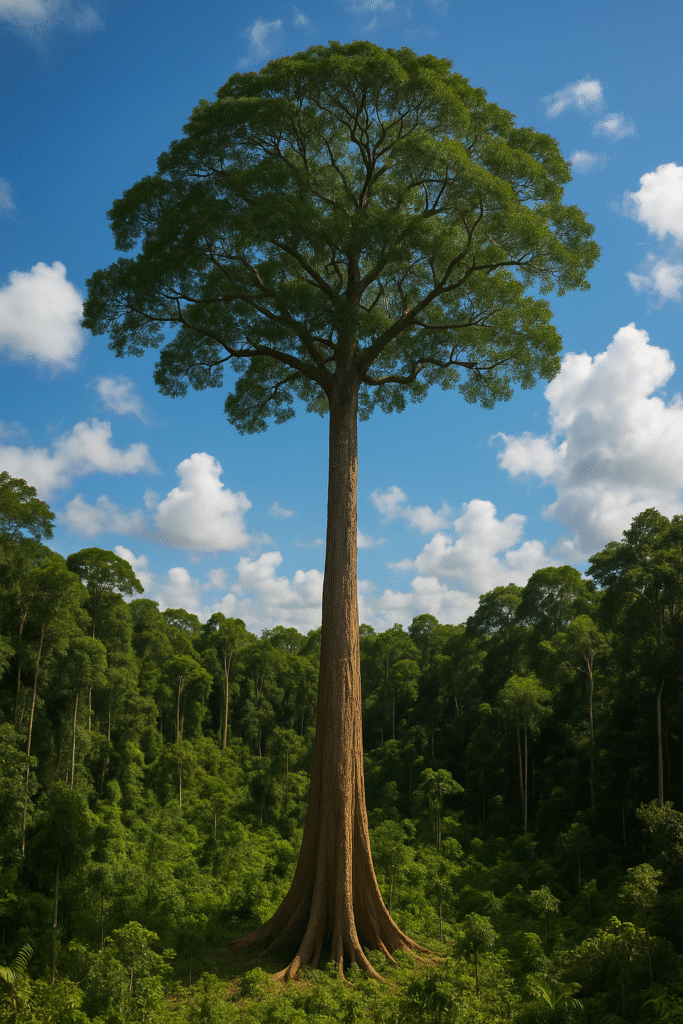The Xingu Brazil nut tree, scientifically known as Bertholletia excelsa, is one of the most majestic trees of the Amazon Rainforest. With its towering height and ecological importance, this tree is not only a symbol of nature’s resilience but also a key player in preserving the Amazon biome and supporting the survival of many species — including humans.
In this article, we’ll dive into the characteristics, uses, and critical role of the Xingu Brazil nut tree for the environment and the communities that depend on it.
Characteristics of the Xingu Brazil Nut Tree
This tree is native to the Amazon and can grow over 50 meters tall, living for more than 500 years. Its trunk is straight and robust, with thick bark that protects it from fires and pests. The tree has large, evergreen leaves that help maintain soil moisture and forest shade.
The small greenish flowers of the Brazil nut tree rely on specific pollinators, especially bees of the Euglossa genus. Without these bees, fruit production is impossible, making the species highly dependent on its ecosystem.
The Fruit and Brazil Nuts
The fruit of the Brazil nut tree is a woody capsule called a “ouriço,” which can weigh up to 2 kg and contains 10 to 25 seeds — the famous Brazil nuts. These fruits take about 14 months to mature and naturally fall to the ground, where animals like the agouti crack them open and help disperse the seeds.
Brazil nuts are highly nutritious, rich in selenium, magnesium, protein, and essential fatty acids. They are a valuable food both domestically and internationally, with Brazil being one of the top exporters. The nut trade generates income for traditional communities and Indigenous peoples in the region.
Connection to the Xingu Territory
The Xingu Indigenous Park, located in the state of Mato Grosso, is home to several villages that maintain a deep ancestral relationship with the forest and especially with the Brazil nut tree. In these regions, the tree is considered sacred — not only as a source of food but also as a part of cultural rituals and oral traditions.
In the Xingu, nut harvesting is done sustainably, respecting the forest’s natural cycles and avoiding deforestation. This model proves that it’s possible to conserve and earn income at the same time.
Ecological Importance
The Xingu Brazil nut tree plays an essential role in biodiversity maintenance. In addition to feeding animals and humans, it helps regulate the climate, store carbon, and protect the soil.
Its wide canopy provides shelter for birds, insects, and small mammals. Its deep root system prevents erosion and improves water infiltration, helping recharge groundwater. The presence of these trees also indicates healthy, preserved forests.
Threats and Conservation
Despite its value, the Brazil nut tree is under constant threat. Deforestation, cattle ranching, and illegal mining are destroying large areas of the Amazon, putting the species at risk.
Although Brazilian law forbids cutting down these trees, enforcement is often weak. Many are accidentally or deliberately killed during illegal burns or land clearing.
Fortunately, environmental organizations, universities, and local communities are working on reforestation and environmental education projects, replanting Brazil nut trees and strengthening sustainable production chains.
Fun Facts about the Xingu Brazil Nut Tree
- The fruit shell is so hard that even its fall doesn’t break it — only animals like the agouti can open them.
- A single tree can produce up to 250 fruits per season, yielding hundreds of nuts.
- The selenium in Brazil nuts is essential for heart health and immune system support.
- Some trees in the Xingu have names given by tribal elders and are seen as living beings with memory.
Conclusion
The Xingu Brazil nut tree is more than just a tree — it’s a symbol of life, balance, and ancestral wisdom. Its protection ensures not only the survival of a species, but also the continuation of traditional cultures, wildlife, and the Amazon rainforest itself.
Protecting this forest giant is everyone’s responsibility — from governments and communities to consumers and businesses. By supporting sustainable products and respecting forest cycles, we help keep the Xingu Brazil nut trees standing — along with everything they sustain.

Cook anywhere with the Fire-Maple Petrel Ultralight Pot. Made from high-efficiency aluminum with a heat-proof handle, this portable and compact pot is perfect for camping, backpacking, and outdoor adventures.
Get Yours NowBring tropical elegance into your space with the Peacock Plant (Calathea Makoyana). Discover its exotic beauty, learn essential care tips, and keep its vibrant leaves healthy year-round.
Read the Care Guide
